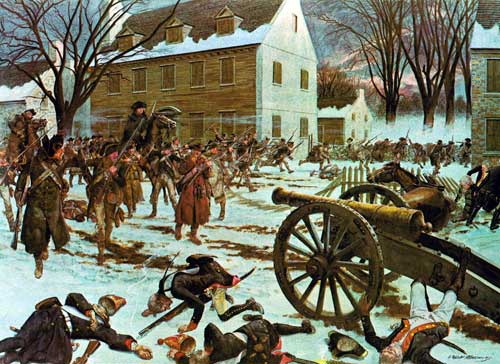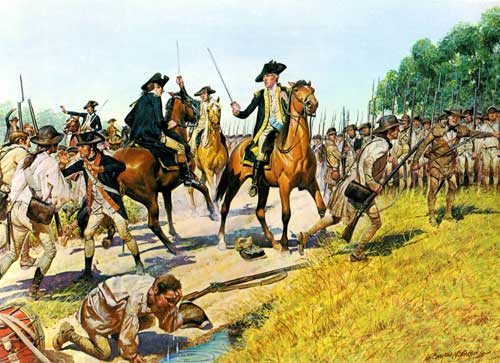Thomas William Gaines, Patriot Ancestor of Gary Bohannon, was born in 1738 in Orange County, Virginia. Established in 1734, Orange County is named in honor of William, Prince of Orange, who in that year married Anne, Princess Royal of England. The County has the distinction of having been the largest Virginia county ever formed, covering a vast territory extending west to the Mississippi River and north to the Great Lakes. James Madison was a resident of Orange County. On August 30, 1776, when Thomas answered the call, he was a 38-year-old farmer, married to Susannah Strother, with two small children and one on the way.
On June 17, 1776, Congress directed Maryland and Virginia to raise six companies of riflemen under congressional authority, not subject to state control. These soldiers were equipped with rifles, not muskets, and specialized in long-range marksmanship. Thomas enlisted for three years in the Maryland & Virginia Rifle Regiment, for a monthly stipend of $6-2/3. The field officers of the regiment were Colonel Hugh Stephenson, Lieutenant Colonel Moses Rawlings and Major Otho Holland Williams. Thomas's company commander was Captain Gabriel Long.
Fortunately for Thomas, the majority of Captain Long's company was slow to muster and depart Virginia to join Washington's army in New York. Long, Lieutenant Nathaniel Pendleton, one sergeant, and eleven privates joined the main army about one month ahead of the main body and took part in the defense of Fort Washington, which fell to a Hessian assault on November 16, 1776. 2,837 Americans, including all of Captain Long's company who were present, became prisoners of the British. Thomas narrowly missed a very bad situation, and his luck would hold throughout his war.
Private Thomas Gaines caught up with the army during its retreat from New York through New Jersey near Elizabethtown, and took part in the battles of Trenton and Princeton. At Trenton, Thomas was part of General Hugh Mercer's Brigade when they pushed into the Delaware River at McKonkey's Ferry, nine miles above Trenton. Once landed on the New Jersey side, Thomas's unit took the River road along with Sullivan's Brigade, then split off, entering Trenton from the west, and joined in the melee. The fight was over in 90 minutes. The troops, overcome with joy at the result of the battle, celebrated, and in spite of Washington's explicit orders for their destruction, casks of captured rum were opened. The General said that because of the rum, the second crossing of the Delaware was more difficult than the first.
Trenton from the west, and joined in the melee. The fight was over in 90 minutes. The troops, overcome with joy at the result of the battle, celebrated, and in spite of Washington's explicit orders for their destruction, casks of captured rum were opened. The General said that because of the rum, the second crossing of the Delaware was more difficult than the first.
At Princeton, on January 3, 1777, as part of Mercer's brigade leading one wing of the army's advance, Thomas and the Maryland & Virginia Rifle Regiment were among the first to encounter British resistance. Forming up for battle in an orchard outside Princeton, Mercer's 1,200 men were attacked by 800 British of the 40th Foot who were able to drive the Americans from the orchard. While General Mercer was killed, his Brigade was rallied by General Washington, and victory was achieved. Thomas had survived his first season of campaigning.
While the main army was wintered at Morristown, Thomas Gaines was stationed at Bound Brook, only a few miles northwest of the British encampment at New Brunswick. This was one of many camps set up in northern New Jersey to monitor and skirmish with British foraging parties who were constantly probing the countryside. In April, Daniel Morgan arrived in Morristown as commander of the 11th Virginia Regiment. The units that remained of the Maryland & Virginia Rifle Regiment were assigned to the 11th Virginia on paper, but remained on patrol duty. General Washington had delayed his planned integration of the riflemen into the main army, because he needed these marksmen and their long rifles to deny the British much needed supplies.
On April 13th, 1777, The British set out from New Brunswick and attacked the camp at Bound Brook from the southeast, fording the Raritan River at night to avoid detection. The American garrison was routed by the attack of Cornwallis's 4,000 English troops, Scottish Highlanders and Hessian mercenaries. The Americans put up a stiff resistance, but were overwhelmed. The attack happened so fast that the garrison commander, Benjamin Lincoln, barely escaped and "did not collect his clothes." Once again, Thomas was lucky enough to escape unscathed from a pitched battle where 60 men were killed or wounded and 50 taken prisoner.
Even with the defeat at Bound Brook, the overall record of the Maryland & Virginia Rifle Regiment, along with the Pennsylvania rifle regiments, was one of success. So much so that General Washington reconsidered his earlier decision to eliminate the rifle companies altogether. Instead, with the arrival of large numbers of new infantry recruits, Washington expanded the force of riflemen and placed them all under the command of Colonel Daniel Morgan, calling the new unit the Provisional Rifle Corps. The best frontiersman were selected for this new unit, which immediately headed for Saratoga in time to help defeat General Burgoyne's army. Most, including Thomas, were transferred permanently to the 11th Virginia. At almost 40, Thomas was undoubtedly happy to remain with the main army.
At Brandywine, September 11, 1777, Thomas and the 377 men of the 11th Virginia were part of General William Woodford's Brigade, initially held in reserve as part of Major General Lord Stirling's 5th Division, guarding their position on Birmingham Hill. "The fire was Close & heavy for a Long time & Soon became General . . . five times did the Enemy drive our Troops from the Hill & as often was it Regained & the Summit often Disputed almost muzzle to muzzle." General Stephen's Brigade, part of Stirling's division, was forced off Birmingham Hill by a superior force of 1,400 redcoats, and began to panic, but the intervention of Thomas's regiment saved their fellows from a rout. Again, Private Gaines had survived a bloody American loss.
To revenge that loss, General Washington conceived a bold four-pronged attack on Howe's 9,000 troop garrison, and on October 4th, 1777, the battle of Germantown was joined. Again, Thomas Gaines was in the thick of the fighting. During the battle, Stephen's Virginia Brigade, which now included the 11th Virginia under General Woodford, assaulted the Benjamin Chew House, where the British 40th Foot had taken refuge. The Americans fired at the house, stormed the house, tried burning the house; nothing worked. They even brought up cannon, but the balls just bounced off the stone walls. They attacked for a full hour, and then, in the fog and smoke and confusion, Anthony Wayne's Pennsylvanians and Stephen's Virginians began firing at each other. At this, both Brigades broke and ran. The Battle of Germantown was over, and, once again, Thomas Gaines had made it through.
After Germantown, the path was clear for the British to occupy Philadelphia, which they did, and Washington's army retreated to a place of safety: Valley Forge. Thomas Gaines was there, and during that winter when the American army was transformed, Private Gaines was promoted to Corporal, and his pay was increased to $7-1/3 per month. Records show that Thomas was at Valley Forge throughout the winter of 1777-78, while many other soldiers left camp to escape the incredible hardship.
A new army, with new confidence, left Valley Forge, and, on June 28, 1778, met the British at Monmouth in the last battle of the Revolution between the main armies.  General Nathaniel Greene, in charge of the battle's right, ordered Woodford's Brigade, which again included Thomas's 11th Virginia Regiment, along with some artillery, to take possession of Comb's Hill on the enemy's left and fire on the British with their four six-ponder cannon. They accomplished their objective, and prevented a British assault from succeeding. As dusk approached, Washington called on Woodford's Brigade to join General Enoch Poor's men in an attack on the British main position, but by the time the units had formed up, darkness was upon them. The Battle of Monmouth was over, and once more, Thomas Gaines was unharmed.
General Nathaniel Greene, in charge of the battle's right, ordered Woodford's Brigade, which again included Thomas's 11th Virginia Regiment, along with some artillery, to take possession of Comb's Hill on the enemy's left and fire on the British with their four six-ponder cannon. They accomplished their objective, and prevented a British assault from succeeding. As dusk approached, Washington called on Woodford's Brigade to join General Enoch Poor's men in an attack on the British main position, but by the time the units had formed up, darkness was upon them. The Battle of Monmouth was over, and once more, Thomas Gaines was unharmed.
Washington used the Middlebrook, New Jersey, grounds again for winter camp in the Winter of 1778–9. He brought about 8-10,000 troops to the camp site by November 30, 1778. But Corporal Thomas Gaines and was given a well-earned furlough, and wintered at home in Virginia , returning to the army to the army's camp before May 1, 1779. The army was reorganized on May 12, 1779, and the 11th Virginia was redesignated as the 7th Virginia Regiment, consisting of 9 companies. In June, the Regiment moved with the main army from New Jersey to New York, to counter a purported British move to attack West Point. "For the security of this very important post, General Washington has arranged his army as follows: Three divisions, consisting of the Virginia, Maryland, and Pennsylvania troops, commanded by Major-Generals Lord Stirling, Baron de Kalb, and Major-General St. Clair, form the right wing, and is commanded by General Putnam as the senior major-general, and posted at Smith's Clove." Fortunately for Thomas, the British retreated back to New York without a fight, and he was discharged at Smith's Clove, New York, on August 29, 1779.
At 41, after three years of the most brutal fighting, and some of the darkest days, of the revolution, Thomas Gaines had done enough for his country and he returned home to his farm. On December 4, 1779, the 7th Virginia Regiment was assigned to the Southern Department, and on May 12, 1780, Thomas's old regiment was captured in the fall of Charleston, with most taken prisoner. Many 7th Virginia soldiers died on British prison ships prior to the peace of 1783, undoubtedly many men that Thomas had known. Fortunately, Thomas's luck, which started with his late arrival in 1776, held out to the end.
